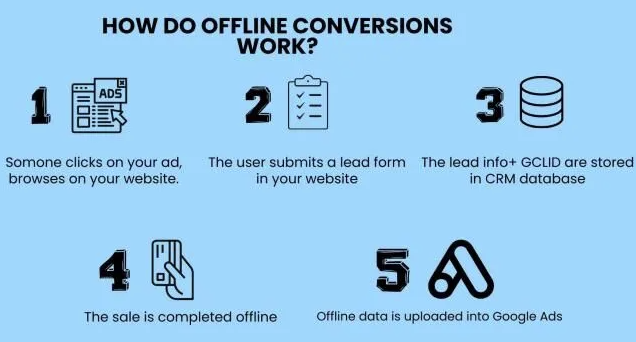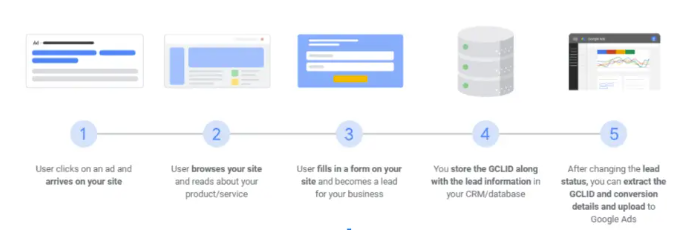It’s easy, with how everything feels online now, to forget that the vast majority of purchases are still made offline. You’d be forgiven for feeling like everything is happening online, but the reality is that still over 80% of purchases in this country are in-person.
So then why does so much of the online advertising sphere seem to talk like the offline world straight up doesn’t exist anymore?
If that’s you, one of the first steps to “un-forgetting” the real world — and how to include it in your digital marketing efforts, as paradoxical as that might seem — is with offline conversion tracking.
Here’s what it is, how it works, and how it can help you better serve the likely majority of your customers.
Image Source: nationalpositions.com
What’s offline conversion tracking and why does it matter?
An offline conversion is exactly what it sounds like: when a customer converts — most often through making a purchase — but does so through an offline channel. (Remember when that was how everything worked?) And yet, we’ve become so accustomed to business happening digitally that it’s easy to neglect this side of things.
Essentially, offline conversion tracking is trying to note all the sales (or, usually sales) that happen offline while also considering that many of those sales are influenced by an online presence with which this offline customer engaged beforehand. These conversions often are in-store or over the phone.
Image Source: analyzify.com
Offline conversion tracking involves uploading information from offline conversions into Google Ads and then analyzing those alongside past leads from the online interactions of these offline converters. More on that in a sec.
Thus, this method is an opportunity to more comprehensively understand how your consumers move through the marketing funnel and end up converting, and through extension which of your strategies are working the best.
While it’s easy to get swept up in just the digital side of things, this acknowledges that online and offline actions are intertwined, and gives you insights into how the two work together for your specific business.
This is also an area where UTMs are extremely important. (If you’re not familiar, check out our past posts about UTMs on the Fujisan blog.) Without UTMs here, you won’t be able to clearly attribute conversions — again, generally sales here — but instead would just have to make vaguely educated guesses about where each sale came from.
Essentially: It’s easy to let offline business slip through the cracks of your analysis and in doing so end up with pretty big data gaps and a generally foggy understanding of what’s working and what’s not. By tracking offline conversions, you’ll eliminate those gaps and be able to have an equally strong insight into offline purchases as online.
A bit more on the benefits
The end point of all of this is that without offline conversion tracking, it’s really tricky to effectively optimize your online marketing.
How this will help you out is all about better understanding your customers, which includes:
- Understanding which days and times of day result in the most conversions
- Understand which regions are converting more often
- On a foundational level, just generally better understanding their journey through the conversion funnel
Essentially, who likes you the most and how can you better cater to their needs? Furthermore, how can you communicate that to them? And on the flip side, who isn’t very receptive to you and why is that? Is it inherent to their behaviors, or would people in this category potentially be more interested in what you’re offering with messaging that’s better catered to them?
These are all extremely valuable things to consider. Understanding offline conversions is a big part of that puzzle.
And, while using this to better know your customers themselves, the other side of that same coin is understanding your own efforts to reach out to them. This includes:
- Identifying your well-received, lead-driving campaigns
- Accurately tracking sources of sales
- Identifying patterns of what’s most often triggering conversions
All of this together helps you understand A) what your customers’ wants and needs are, B) how you can better address those, and C) how you can communicate to them effectively that you’re doing so. Really, that’s what optimization is.
Setting it all up
Image Source: nationalpositions.com
So you’ve decided you want to be more diligently tracking offline conversions — congratulations on making the right call!
The first step is integrating Google Click ID with whichever customer relationship manager — or CRM — tool you’re using, whether that’s HubSpot or another. (If you’re reading more about the Google Click ID, you’ll likely see it referred to under the acronym GCLID.) Google has a step-by-step guide on setting up offline conversion imports via GCLID on their site.
This process comes together by combining the GCLID and the lead info from the customer’s online interaction(s) into a CRM database. Then once an offline conversion is made, the data from that can be uploaded into Google Ads, where you can then visualize everything together accordingly.
Once you’ve integrated GCLID with your CRM, you’ll decide which conversions you want to track and from there will create conversion actions in your Google Ads account.
After, you’ll import conversion actions: Go to “measurements” in Google Ads, click on “conversions”, and click “import”. If everything is set up on your CRM, you can select “other data sources or CRMs” and “track conversions from clicks.”
We know that was a lot, but here are the steps broken down:
- Generate a Google Click ID
- Integrate the Google Click ID with your CRM
- Collect offline conversion data
- Upload the offline conversion data to Google Ads
- Create conversion actions via “Tools & Settings” and select “Conversions
- Click the + button and choose “Import via other data sources or CRM”
- Select “track conversions from clicks (or whatever your focused metric is)”
- Map offline conversion data fields
- Import conversion actions
- Go to “Measurements”
- Select “Conversions”
- Select “Import from other data sources or CRMs” and choose “track conversions from clicks (or whatever your focused metric is)”
- Review and confirm
And that’s it! From there you can start working on better knowing your customers and how you can support all of them — not just the ones who make online purchases!







